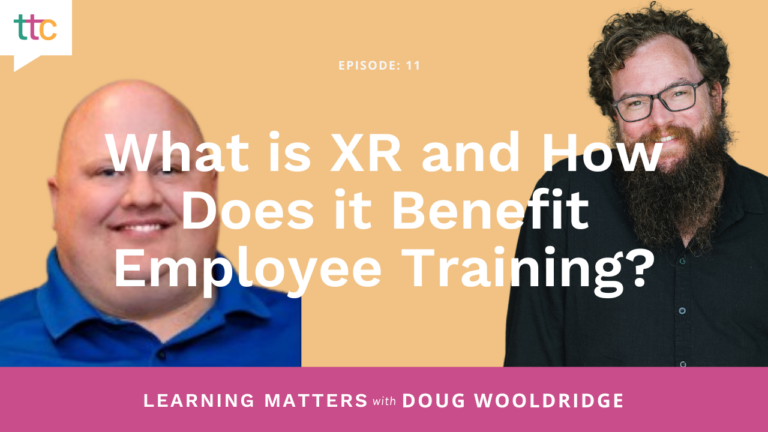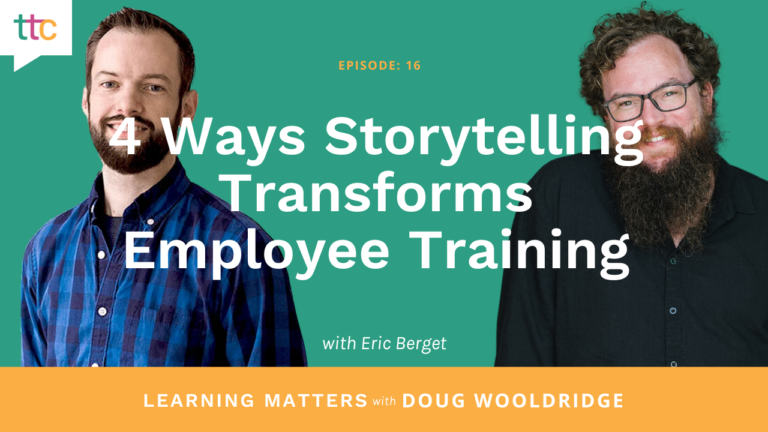Almost every day, each of us engages with some form of video. It could teach us how to build something or how to apply makeup, we might watch someone dance, laugh at absurdity or learn important leadership skills. There is a video out there for just about everything. And quality is not even an issue for most of us. Many videos are created with iPhones, PC/MACs, or other devices. However, when creating videos for learners we should take quality a step higher than what we typically watch on YouTube or TikTok. We want to build solid, relevant, instructionally sound products that move our learners forward, help them understand complex topics through visuals, and give them demonstrations of how-tos in a clear and concise way.
This blog will cover the two major categories of educational video, the eight different types of video learning, and how to use mixed methods to achieve real results. It may also convince you that you may need Extra Hands You Have to Hold® and trust your work to the pros!
Video Editing Tools and Equipment
Video Editing
Almost all great video productions have been professionally edited. No matter what type of video you are creating you will need to edit it. There are great tools to do this, but it’s imperative to learn them well or have someone who knows how to use them to do the editing.
- Adobe Premiere Pro is the preeminent video editing software. It can help you edit any type of video and it’s not hard to learn but requires practice.
- Apple Final Cut Pro is a MAC based program that is a little harder to learn but a great tool once you are proficient
- Movavi Video Editor Plus if you want a simple, less expensive option.
There’s no getting around learning editing software or using a pro to handle this task.
Filming Equipment
It’s also important to have appropriate filming equipment. A videographer will have this equipment if that’s the route you go.
- DIY video: You can use an iPhone but you have to have something to keep it stabilized. There are iPhone tripods and stands in every size and type. Some also have lighting which is also an indispensable part of video filming.
- Lighting and Sound: Again, your video professional will come with a lighting kit and appropriate sound gear.
- Phone videos: Keep in mind what you are seeing on your phone is not what someone will see on a PC or MAC. A phone video is a very small image. So editing on a larger platform – not a phone – is advised. This way, the video will look great in both mediums.
Innovative Tip: The last element to keep in mind is time. You should keep all videos under 3 minutes in length. Learners can only endure so much at one time, and they may be watching videos at work. Bite-sized pieces of learning have been shown to work best!
Two Major Categories of Educational Video
There are two major categories of educational video – stand-alone video and mixed media video (which includes one or more types of stand-alone video and usually another learning modality as well).
- Stand-alone video (of any type) is a category of video where no other explanation or additional information is required. As sound instructional design always includes some form of practice, feedback, and assessment, a stand-alone video isn’t recommended. In fact, it should be avoided! However, there are two instances where it’s a perfect choice.
- How-to’s. These are perfect stand-alone videos and most of us have viewed many in our lifetime — they show step-by-step instructions for how to do something! The most important element of this type of stand-alone video is to display the action described when the narrator says, “As you can see…”
- Message or PSA. These are one-way communications used to express an opinion, a safety reminder, or a message from management. They can be a ‘talking head’ video where the video is filmed as only the bust of the presenter (the closest you should get) or a full body shot where the narrator is shown head to toe on screen delivering the message. In addition, make sure the background is eye-pleasing or relevant to your business. The gray side of a cubicle is not a great place to film these kinds of videos!
- Mixed media video is a different video category that has different video types that are edited together to create a dynamic presentation. For instance, let’s say you start off with a talking head narration briefly describing a concept. To make it mixed media, you would edit to another video showing what the narrator has described while the voiceover is still going. This is by far the most effective and most popular type of educational video.
Now let’s delve deeper into the types of videos and how you can edit them together to create a mixed media video AKA a powerful learning tool. In addition, most mixed media videos are embedded into a learning tool so that self-checks and assessments can be completed, rounding out the learning cycle. Tools like Articulate Storyline or Adobe Captivate are great places to ‘house’ these types of mixed media videos.
Types of Video
1. Live Action
This type of video is a dynamic presentation of live action demonstration with multiple perspectives, a demonstration of a soft skill, interviews, or anything to do with real people. Our ‘talking head’ videos fall into this bucket.
- Pros: Great live-action videos can be a centerpiece of training. Nothing tells a story like real people — especially if they are filmed and edited well!
- Cons: This type of video can be spectacular when done correctly and very, very bad when done incorrectly. They can also be expensive to produce and difficult to film if you don’t have a professional team.
- Tips:
- Utilize scripts to be engaging, conversational, and relevant.
- Resource non-company-based actors to sign a release form allowing their image to be used — this protects your video production from liability down the road.
- Tools: Someone with video filming and editing experience should be employed for the best result since this type requires acumen to film.
2. Photo Montage
A photo montage is comprised of photos in a slide show fashion with simple texts, music, voiceover other effects to give the learner a visual of a place or experience.
- Pros: Very easy to produce, giving you the ability to create a video-like sequence in your learning without having to create an actual video! It’s an engaging way to draw the learner in and even provide step-by-step demonstration.
- Cons: There really aren’t any cons to this type of video — it’s great for almost any form of learning where visuals are useful or necessary.
- Tips:
- Utilize pictures with the same quality – you don’t want some very clear photos and others that are grainy!
- Tools:
3. Motion Graphics
Motion graphics help convey a message through moving images, often using data visuals, moving text, and geometric shapes. They are usually mixed with voiceover and music.
- Pros: Motion graphics can truly help your learner visualize the message in a dynamic way. Unless it’s a marketing message or a straightforward explainer video, they are usually used in a mixed media format that includes other types of video or learning modalities. For instance, a concept may be described in Articulate Storyline, then the embedded motion graphic that follows the description gives the learner a more in-depth, emotional view of the subject. Or a motion graphic can create a powerful motivator as an introduction to a course.
- Cons: Motion graphics are often passed off as learning but they are most often one piece of a larger learning message. They are not easy to create but for those who know Adobe Suite, they are fairly easy to assemble.
- Tips:
- Utilize scripting.
- Have the artist meet with the SME or the ID to understand the vision — this will avoid expensive re-work.
- Tools:
- Adobe After Effects (templates available)
- Adobe Premiere, Photoshop, and Illustrator
- Cinema 4D
4. Screencast
This is by far one of the most popular types of videos – often called screen capture or screenshot videos. They are an essential part of today’s technology learning, and they allow the learner to follow along as the instructor reviews software.
- Pros: Learners can be given the chance to try it for themselves in self-check reviews, etc. Almost all of us have been through a screenshot tutorial aka screencast.
- Cons: If the technology is complex and the learner is not given an embedded opportunity to practice in the learning, it may be a case of ‘too much at once’ – almost impossible to remember without reinforcement.
- Tips:
- Utilize this type as many companies do — a part of a blended modality where the learner takes the training and then is part of a classroom training where they practice under the guidance of an instructor.
- Ensure quality so the screenshot is not blurry or saved at too low a DPI.
- Tools:
5. Animation
Animation is a great way to explain a concept you’ve partially developed, for instance, in an eLearning and want to show an example. An animated character can be your narrator for a program — there are so many ways to use this modality!
- Pros: Animated characters are a less expensive alternative to live-action video and relatively easy to create with the tools available today.
- Cons: If you’re looking for custom animation or 3D animation, it’s a job for a pro since 3D can be complex, and time-consuming to design and develop.
- Tips:
- Utilize scripting.
- Tools:
6. Live Streaming
This type encompasses a live broadcast video straight to viewers.
- Pros: The only time this is truly beneficial to learning over other types is when you are having a conference and want to broadcast speakers or other subject matter experts to your learners or those not in attendance.
- Cons. This can get complex and pricey. To make it most effective, you need multiple cameras, a director, and a producer. Unless you have a dynamic way to stream this content – a professional way like a Ted Talk – it’s pretty much a waste of money and time. Sound is difficult in ballrooms and large conference rooms without the right equipment and lighting is often a problem.
- Tips:
- Leave this one to the pros and only pick the projects that you truly want to invest in.
- Tools:
- Facebook Live
- Vimeo
- OBS – open broadcast studio but again, it’s not the tool, it’s the technique that makes this one successful.
7. Whiteboard
Whiteboard uses a hand with a pen or a pencil to give the look of the speaker creating images. This type of video has been very popular in recent years.
- Pros: Create learner engagement because it ties in narration and real-time drawings to what’s being shown. They are a great way to convey a concept in a ‘reveal and read’ kind of way.
- Cons: This concept is now very overused and learner fatigue becomes evident quickly.
- Tips:
- Keep very short and should be scripted carefully to avoid rework.
- Time the drawings to the narration.
- Avoid using it as a stand-alone learning tool. These should be used in a mixed media way, usually embedded in eLearning.
- Tools:
8. Text Videos
Text videos are are almost always text-based sans narration. It’s sometimes called “Kinetic Typography”. Many times the text videos will be mixed with motion graphics to make the visuals more stimulating, but sometimes, just the text is enough. They are used to convey a message of some kind. These are almost always some kind of mixed media piece unless it’s a short marketing message.
- Pros: Text based videos are an ‘in your face’ way of making the learner pay attention by reading text.
- Cons: These videos can become tedious very fast if they are too long or there is too much text. They are really not meant to be a stand-alone learning piece – only a piece of mixed media.
- Tips:
- Again – scripting, scripting, scripting. Screen text is usually very short sentences per screen that come together to convey a message.
- Tools:
Mixed Media Video + Learning Courses
This is the most solid type of learning experience using video. As we learned earlier, mixed media can incorporate multiple types of video through editing. It can also be inserted into an eLearning course to explain complex topics, provide demonstration, add learning engagement, to scenario-based learning. The possibilities are endless.
Why does this type of mixed media matter? Because if the videos are embedded in an eLearning course or template, you can add self-checks, assessments, practice elements, progressive and branched scenarios to make it a true learning experience. Good learning includes the elements of motivation, demonstration, practice and feedback.
Video alone without these elements does not close the learning loop and the experience may not be retained fully. Adding the elements of practice and feedback through the methods above ensures a great retention level and a solid learning experience. And you can use video alone. You just need to wrap the video in an eLearning shell so you can create practice and feedback slides. Here are just a few examples of how to mix media with eLearning followed by practice/assessment:
- eLearning + talking head video/motion graphic demonstration
- eLearning + text-based video + photo montage
- eLearning + taking head video + screencast technology video
- eLearning + white board video + animation demonstration video
You can easily see the list is endless. Again, the importance of mixed media with eLearning is learner engagement and allowing the learner to practice and self-assess what they’ve learned. Be creative — the sky’s the limit!
Video is one of the most powerful modalities for learning (and persuasion!) in the world today. Most of us engage with a video at some point in the day – whether it’s embedded in a newcast or animation used in a commercial (ahem, mixed media!). Whichever style you choose, choose the right type of video for effective learning and ensure you outsource to professionals when necessary — it will save you time and money in the long run!
Three main reasons you may way to consider an experienced professional: quality, time to delivery, and tools and equipment. Need Extra Hands You Don’t Have to Hold® to produce any (or all!) of the video types mentioned in this blog post? Tap in to our talent today! Our Innovators on Demand® make outsourcing easy.







